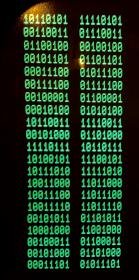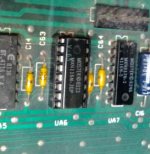JonB
Veteran Member
Right, back to the memory fault.
I've written a short proggie that pokes a random number into upper RAM at consecutive addresses. If on PEEK I get a different value, I conclude the RAM has a problem. However, I'm looking for patterns, so I wrote a short "int to binary" subroutine and ran it.

Looks like bit 6 is misbehaving. On he left hand column is the random byte as POKEd, and on the right hand side is the PEEKed value.

According to this lovely schematic, upper RAM bit 6 is the 4116 DRAM at UA6.
I've written a short proggie that pokes a random number into upper RAM at consecutive addresses. If on PEEK I get a different value, I conclude the RAM has a problem. However, I'm looking for patterns, so I wrote a short "int to binary" subroutine and ran it.

Looks like bit 6 is misbehaving. On he left hand column is the random byte as POKEd, and on the right hand side is the PEEKed value.

According to this lovely schematic, upper RAM bit 6 is the 4116 DRAM at UA6.
Last edited:

